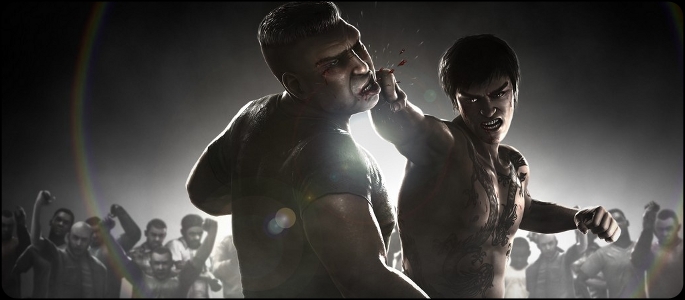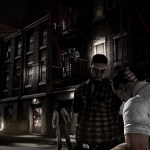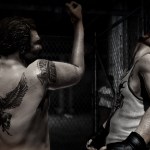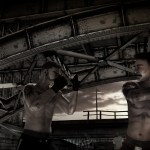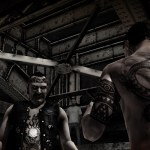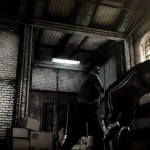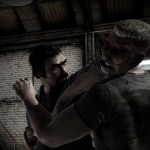When Sony’s PlayStation Move launched back in September, it came out swinging. One of the only things missing from the intial launch line-up, was a good fighting game. The Fight: Lights Out just released for the PlayStation Move to fill that void. Is it a worthy contender as a motion-controlled fighting game? Find out in our in-depth review.
After first seeing how accurate the PlayStation Move controller tracked user’s motions, a few particular types of games came to mind that would fit perfectly with the device: a Star Wars lightsaber game, sports games, and a fighting game. The Fight: Lights Out is the first fighting game to utilize the PlayStation Move controller, boasting one-to-one precision and realistic movements. However, The Fight: Lights Out is not the knockout Sony was hoping for.
Upon starting up the game, you’ll have 5 minutes or so to get set up as the game installs. Sadly, this is probably the most enjoyable time you’ll spend with The Fight: Lights Out. Make sure to clear out plenty of space. Not only will this prevent you from accidentally breaking something, but the game requires a lot of space to calibrate the two required PlayStation Move controllers. It’s also a good idea to put on the Move’s wrist straps and you’ll be throwing some pretty hard punches.

Despite requiring so much space, don’t expect to use it. Although you’re welcome to “move your body”, you cannot move your feet or else you risk messing up the calibration between the PlayStation Eye and the two Move controllers. That’s right, it’s a fighting game where you can’t move your feet. If you do move your feet and the calibration is thrown off, your on-screen character’s movements and punches will be thrown off as well. Sure you can press circle to re-calibrate, but nothing takes you out of the “fight” more than having to re-calibrate. Speaking of calibration, plan on doing it constantly. Before every match or training session, you’ll have to calibrate the Move controllers by sticking them straight out at your side (this is where all the space is required), and you have to be standing far enough away from the PlayStation Eye for your entire wing span to be shown on screen. If you’re a tall person, or have longer arms than most, you’ll find yourself standing as far back as 8 feet away from the Eye, which isn’t at all convenient. Next put the two PlayStation Move orbs to your chin, and you should be ready to go. The fights and training sessions last just mere minutes each, so prepare to be calibrating anywhere between 6-10 times in a one 30 minute bout of gameplay.
Danny Trejo, actor and star of Machete, takes on the role of Duke, your trainer. He actually plays the part well, as the game is trying to go for this gritty, underground feel and Trejo is definitely a tough, intimidating son of a bitch. The real issue with Duke is the script. All he really does is just yell at you and doesn’t offer anything particularly helpful. It was particularly laughable to hear him scream at you telling you how tough the competition is going to be (all while holding pink and blue glowing Move controllers), then in the same breath to tell me not to move my feet. Some tough guy, can’t even move his feet.
The game’s faults don’t stop there. The gameplay is atrocious. Not one second of the fighting is enjoyable. Punches just don’t register properly. You could throw your very hardest punch and it register in the game as a weak, light jab. There is little differentiating a powerful punch from a love tap, so you learn quickly not to waste energy throwing too hard of punches. Movement feels awkward too. To walk toward the opponent, press the Move button and tilt the Move controller forward until you close in. Tilt to either side to sidestep. The only thing the gameplay gets right is that it does a good job tracking the direction of the punches; if you throw a right hook or an uppercut, so will your character. Just don’t expect any oomph behind then.

On the subject of your character, you have to create your own fighter using an extremely limited list of presets. Don’t plan on having a character look remotely like you. That goes for facial features, skin tone, or even hair styles; everything is just so limited. Once the look of your fighter is complete, it’s time to set attributes. You’re given a number of skill points to add to different attributes like strength, chin, heart and stamina. As you play through the game and train, you’ll earn additional skill points to assign to the different attributes, building out your fighter’s abilities. Also as you progress, you’ll unlock special “dirty” moves that you can use to your advantage during the fight.
Training is important to growing your fighter’s abilities. Though there aren’t many options available in training. You can spar, hit the heavy bag or the most enjoyable out of the bunch, hit the speed bag. The heavy bag is a perfect way to show just how bad the gameplay is, a red circle will appear telling you where to hit the bag. About half of your punches won’t even hit the target and instead will punch a different area. It almost encourages you to slow down and weaken the punches you are throwing to make them more accurate. The speed bag at least is decent, it registers punches pretty well, and if you get in a rhythm, it can be like a real speed bag.
On a better note, there is plenty of fights available as you move forward throughout the fight cards. But because the fighting gameplay is so broken, and the character you’ve created never feels like your own, there isn’t much incentive to progress through the fights. The entire single player mode feels about as uninspired and bland as the boring fighters you’ll face. After a few solid matches, I had to take breaks, not because it was too physically demanding (though it is a good workout), it was just that frustrating. I can’t imagine putting in an hour’s worth of game time in one sitting, err, standing.

Multiplayer isn’t any better. Having two players requires so much more room, more calibration, and more horrible fighting mechanics. I could easily imagine two friends playing this game, getting so frustrated, and then a real brawl breaking out between them. There’s some type of betting system that allows you to watch fights and place bets on the outcome, though, the fights aren’t good enough of a show to watch.
Graphics are decent at best. The game is, as mentioned earlier, going for a dirty, gritty, underground look and feel. While it does achieve that to a point due to the game’s many parking garage looking settings, everything just feels really gray, washed out and boring. The sound is very poor, the game’s intro music could make your ears bleed. During fights there isn’t much going on in the way of sound, certainly no smack-talking, grunting, or even the sound of impact from a ferocious punch (there isn’t any of those going on anyway).
The entire game just feels uninspired and wonky. The fighting mechanics grossly underperform and there isn’t any incentive to keep fighting. The game tries entirely too hard to come off as tough and gritty, only to throw punches weaker than an AARP member with severely low blood sugar. The Fight: Lights Out is a terrible game that couldn’t fight its way out of a wet paper bag. The only way we could recommend this game, is if you enjoy taking a beating again and again or if you like just throwing your money away. Yes, it’s that bad.
PlayStation LifeStyle’s Final Score
-Awful fighting mechanics; can’t move your feet -Danny Trejo yells a lot |
 |
–
